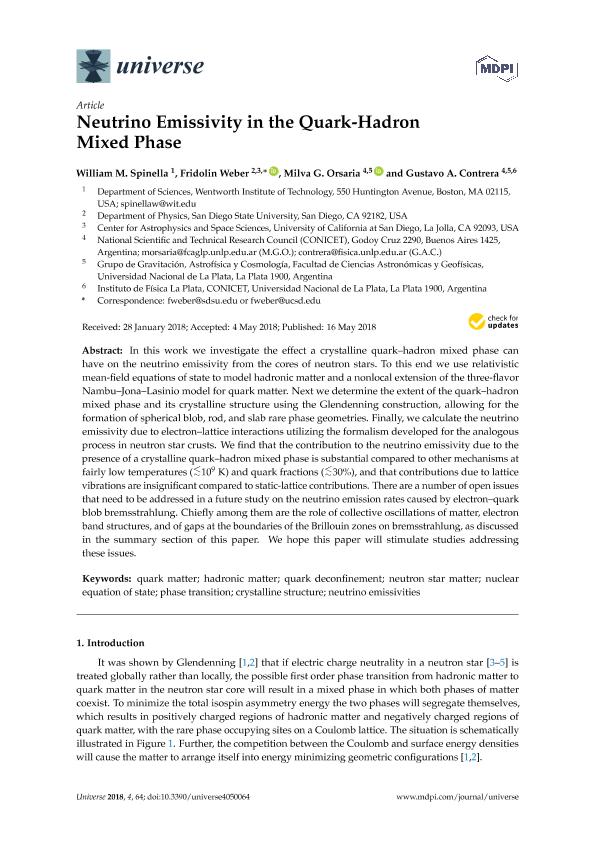Mostrar el registro sencillo del ítem
dc.contributor.author
Spinella, William M.
dc.contributor.author
Weber, Fridolin

dc.contributor.author
Orsaria, Milva Gabriela

dc.contributor.author
Contrera, Gustavo Aníbal Gabriel

dc.date.available
2020-03-17T16:57:17Z
dc.date.issued
2018-05
dc.identifier.citation
Spinella, William M.; Weber, Fridolin; Orsaria, Milva Gabriela; Contrera, Gustavo Aníbal Gabriel; Neutrino emissivity in the quark-hadron mixed phase; MDPI Multidisciplinary Digital Publishing Institute; Universe; 4; 5; 5-2018; 1-15
dc.identifier.issn
2218-1997
dc.identifier.uri
http://hdl.handle.net/11336/99846
dc.description.abstract
In this work we investigate the effect a crystalline quark-hadron mixed phase can have on the neutrino emissivity from the cores of neutron stars. To this end we use relativistic mean-field equations of state to model hadronic matter and a nonlocal extension of the three-flavor Nambu-Jona-Lasinio model for quark matter. Next we determine the extent of the quark-hadron mixed phase and its crystalline structure using the Glendenning construction, allowing for the formation of spherical blob, rod, and slab rare phase geometries. Finally, we calculate the neutrino emissivity due to electron-lattice interactions utilizing the formalism developed for the analogous process in neutron star crusts. We find that the contribution to the neutrino emissivity due to the presence of a crystalline quark-hadron mixed phase is substantial compared to other mechanisms at fairly low temperatures ( < ∼ 10 9 K) and quark fractions ( < ∼ 30%), and that contributions due to lattice vibrations are insignificant compared to static-lattice contributions. There are a number of open issues that need to be addressed in a future study on the neutrino emission rates caused by electron-quark blob bremsstrahlung. Chiefly among them are the role of collective oscillations of matter, electron band structures, and of gaps at the boundaries of the Brillouin zones on bremsstrahlung, as discussed in the summary section of this paper. We hope this paper will stimulate studies addressing these issues.
dc.format
application/pdf
dc.language.iso
eng
dc.publisher
MDPI Multidisciplinary Digital Publishing Institute
dc.rights
info:eu-repo/semantics/openAccess
dc.rights.uri
https://creativecommons.org/licenses/by-nc-sa/2.5/ar/
dc.subject
Quark matter
dc.subject
Hadronic matter
dc.subject
Quark deconfinement
dc.subject
Neutron star matter
dc.subject.classification
Astronomía

dc.subject.classification
Ciencias Físicas

dc.subject.classification
CIENCIAS NATURALES Y EXACTAS

dc.title
Neutrino emissivity in the quark-hadron mixed phase
dc.type
info:eu-repo/semantics/article
dc.type
info:ar-repo/semantics/artículo
dc.type
info:eu-repo/semantics/publishedVersion
dc.date.updated
2020-02-20T15:13:26Z
dc.journal.volume
4
dc.journal.number
5
dc.journal.pagination
1-15
dc.journal.pais
Suiza

dc.description.fil
Fil: Spinella, William M.. San Diego State University; Estados Unidos
dc.description.fil
Fil: Weber, Fridolin. San Diego State University; Estados Unidos
dc.description.fil
Fil: Orsaria, Milva Gabriela. University of California at San Diego; Estados Unidos
dc.description.fil
Fil: Contrera, Gustavo Aníbal Gabriel. Consejo Nacional de Investigaciones Científicas y Técnicas. Centro Científico Tecnológico Conicet - La Plata; Argentina. Consejo Nacional de Investigaciones Científicas y Técnicas. Centro Científico Tecnológico Conicet - La Plata. Instituto de Física La Plata. Universidad Nacional de La Plata. Facultad de Ciencias Exactas. Instituto de Física La Plata; Argentina
dc.journal.title
Universe
dc.relation.alternativeid
info:eu-repo/semantics/altIdentifier/url/http://www.mdpi.com/2218-1997/4/5/64
dc.relation.alternativeid
info:eu-repo/semantics/altIdentifier/doi/https://doi.org/10.3390/universe4050064
Archivos asociados
